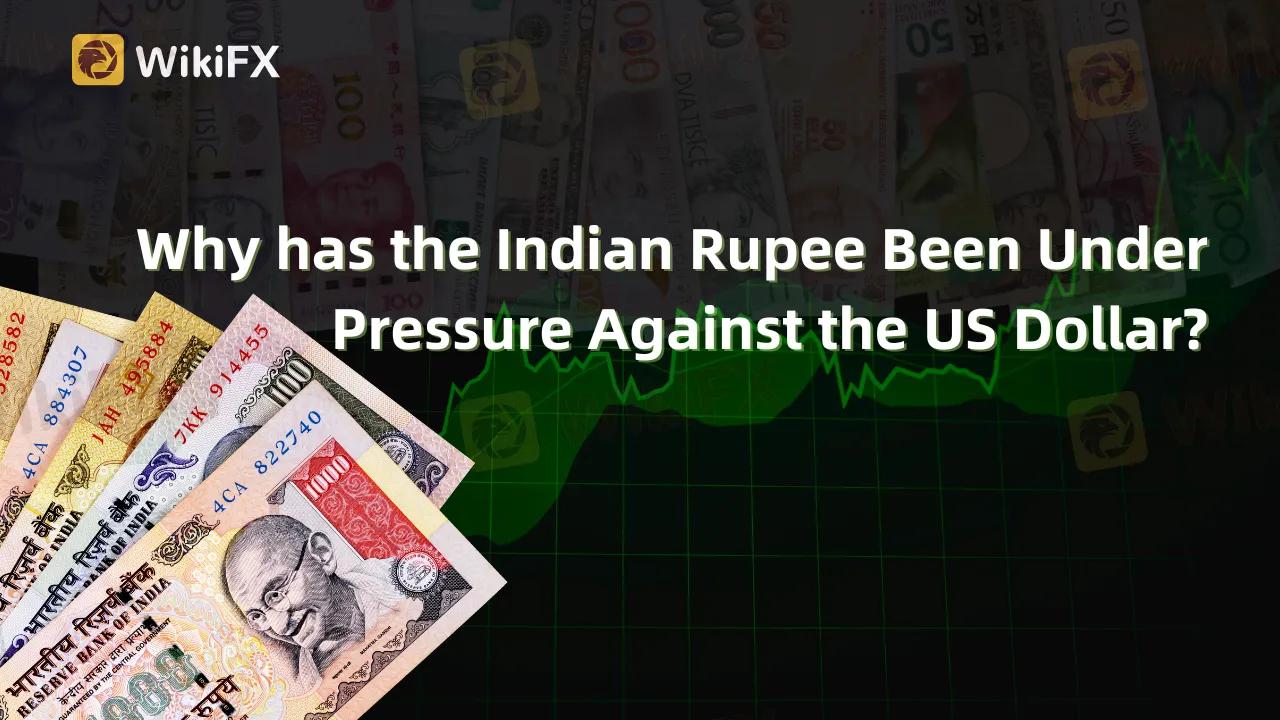简体中文
繁體中文
English
Pусский
日本語
ภาษาไทย
Tiếng Việt
Bahasa Indonesia
Español
हिन्दी
Filippiiniläinen
Français
Deutsch
Português
Türkçe
한국어
العربية
Why has the Indian Rupee Been Under Pressure Against the US Dollar?
Abstract:The Indian rupee has been under pressure against the US dollar due to dollar demand from importers and a resurgence in US rates. Despite a slight recovery, the rupee continues to trade near its lowest level in two weeks. Traders are monitoring whether the rupee's downward trend will persist.

The Indian rupee, which had lost ground to the US dollar in the previous three days, gained some support from early dealers, as forward premiums continued to fall.
By 10:54 a.m. IST, the rupee was trading at 82.20 to the dollar, almost unchanged from the previous session. The local currency will be seeking to end its losing streak, which has brought it to its lowest level in two weeks.
According to Amit Pabari, managing director of CR Forex, the rupee has been under pressure due to dollar demand from importers and a resurgence in US rates.
Traders are watching to see whether the rupee's downward trend would continue after a weak start.
“As expected, it's quiet at open.” “As a trader, you're basically gauging whether the up move (on USD/INR) has more legs or whether it'll stall around here,” a spot dealer said.

The move upward in USD/INR frequently occurred later in the session, and he believes it will happen again.
Other Asian currencies were mixed, but the dollar index fell just slightly.
The tepid advance comes as the likelihood of the US Federal Reserve raising rates by 25 basis points in May approaches 90% and there are no top-tier US data releases.
Meanwhile, USD/INR premiums remained roughly constant after Wednesday's drop. Swap dealers believe that the rise in US rates in response to higher-than-expected UK inflation statistics is to blame for the 1-year USD/INR forward implied yield falling to its lowest level in six weeks.
WikiFX provides comprehensive and up-to-date news, analysis, and expert opinions on global currency markets. Users can access data on major currencies, including the US Dollar, Euro, British Pound, and Japanese Yen, among others. The platform's user-friendly interface allows traders to quickly access relevant information, such as exchange rates, economic indicators, and market analysis.
Download the App: https://social1.onelink.me/QgET/px2b7i8n

Disclaimer:
The views in this article only represent the author's personal views, and do not constitute investment advice on this platform. This platform does not guarantee the accuracy, completeness and timeliness of the information in the article, and will not be liable for any loss caused by the use of or reliance on the information in the article.
Read more

Yen Rebounds! Is This the Opportunity Investors Have Been Waiting For?
The Japanese yen has staged a sharp rebound, breaking below key technical levels against the U.S. dollar. With diverging central bank policies, heightened risk sentiment, and a shifting macro backdrop, is this a real opportunity—or a trap?

VIPS Group of Companies Exposed: ED Seizes Assets in 100-Crore Ponzi Forex Scam
The Enforcement Directorate (ED) has cracked down on an INR 100-crore scam involving illegal forex trading and Ponzi schemes by seizing immovable assets and digital devices besides freezing bank accounts across multiple cities in India. Read more.

Foraxi Joins the WikiFX Family
Explore how the addition of Foraxi to the WikiFX family opens up forex trading growth avenues for traders around the world.

Iran’s Strait Strategy: Is the World Ready for $100 Oil?
Tensions in the Middle East are rising quickly, and global oil markets are already feeling the pressure. Since Iran and Israel entered open conflict, oil prices have jumped from around $60 to nearly $80 per barrel. Now, with the United States joining the fight and launching strikes against Iran, the situation has become even more serious. Iran’s threat to seal off the Strait of Hormuz could ignite a global energy meltdown, spike oil prices beyond $100, and unleash economic chaos across the world.
WikiFX Broker
Latest News
Consob Blocks 7 Fraudulent Investment Websites Amid Ongoing Crackdown
MyFundedFutures Tightens Compliance Measures Following Regulatory Pressure
Investors Beware! The Pound May Face a Downturn in the Second Half of the Year
Latest FCA Warning List Out! Beware & Protect Your Money
Stock futures rise after Trump says Iran-Israel ceasefire is in effect: Live updates
UK vows to spend 5% of GDP on national security by 2035
NATO wants allies to spend 5% of GDP on defense: This chart shows how hard it could be
Can Germany afford a 5% NATO defense spending target?
Watch Out: FCA Issues New Warning List of Scam Firms
Gold Prices Down in Early Hours of Spot Trading Today in India
Currency Calculator


